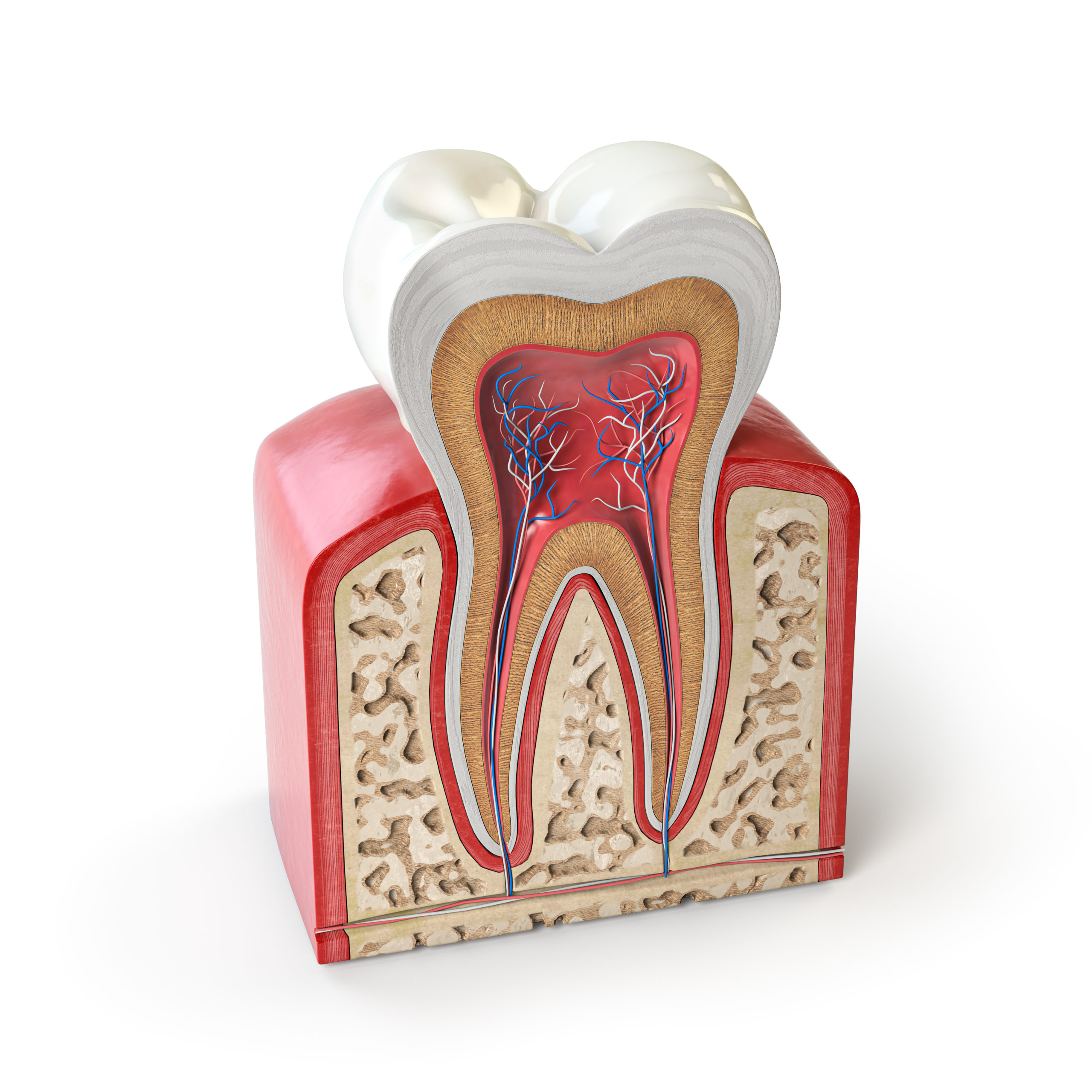
Toothaches are a major source of dental pain. Tooth pain can originate from a number of sources. From exposed dentine to leaky fillings, traumatic pressure, hypersensitivity from grinding or abrasive brushing, or referred pain from gums or nearby sinuses. Generally the most severe toothaches arise within the pulps, or “nerves”, of the teeth. This is commonly called pulpal pain or “nerve pain”.
How does pulpal pain, or “nerve pain”, occur in a tooth?
A toothache that can be described as an 8 to an 11 out of 10 would usually be caused by pulpal pain. It will likely be hot and cold sensitive, worsened with pressure, and give a severe ache. The primary source of this tooth pain is pulpal infection.
The first stage of tooth infection is when bacteria breaks down the outer layer of the tooth. To achieve this, bacteria needs to be well established on the tooth surface and given access to carbohydrates to metabolise. Bacteria quickly forms into a soft white layer called plaque. The longer it is left undisturbed, the greater the decay potential. If one little spot of plaque is left for more than 24 hours and given access to carbohydrates, particularly sugars, then tooth decay can occur. Once decay reaches inside the tooth it is unlikely to stop without intervention.

Early tooth decay, or tooth infection, can be treated with fillings. The decay is removed by a dentist and the lost tooth structure is restored using composite resin, a white tooth coloured material, in most cases. If left untreated this decay will usually extend until it reaches the interior of the tooth – the pulp. The pulp is a nutrient rich area that feeds the tooth blood and nerves, it is what makes the tooth alive. Imagine bone marrow but for teeth. Unfortunately, it is so nutrient rich that as soon as bacteria reaches here it spreads and multiplies almost instantly. The infected tooth becomes an infected pulp and severe tooth pain, or pulpal pain, results.
Why is pulpal pain so bad?
The nutrient-rich, lush area of the pulp becomes the perfect breeding ground for bacteria. It spreads quickly, releasing nasty toxins into the bloodstream. The body detects the bacteria has invaded areas it shouldn’t be and mounts a defence to try to destroy the bacteria. When there is an immune response, inflammation occurs. However the pulp is encased by hard tooth walls and doesn’t allow for swelling. So pressure builds up within the pulp, full of tiny nerves which essentially become crushed. That’s when we experience severe toothaches.

Does pulpal pain go away on its own?
Treating a toothache can seem scary, expensive, and possibly even more painful, so you may be tempted just to let things play out. This is not a good idea.
The type of bacteria that invades the pulp is bacteria our body is usually good at destroying, however that tight area inside the tooth is very hard to reach. Larger white blood cells can’t access the pulp very well and the immune system isn’t capable of clearing out the bacteria on its own. This means the infection cannot be cleared without professional intervention.
If you’re lucky, an equilibrium could be achieved where bacteria is cleaned from the body as it leaks from the tooth and the pain may lessen. These states are usually only temporary however and a large bacterial load is likely to resurface in the future. You’ll also always have a source of bacteria entering your bloodstream potentially causing other health effects. If the bacterial load becomes more severe then you could also develop cellulitis, swelling within the nearby tissues. The swollen areas become very tender and may even extend further back to your airways, restricting airflow.
Treatments for pulpal pain
Antibiotics
If you’re in a lot of pain, there’s a fair amount of swelling, or you’re just too scared to see the dentist right away, a course of antibiotics can help to clear the infection from the nearby tissues. This is only a very temporary solution however. Antibiotics, like the immune system, is not able to properly access the pulps of teeth and cannot remove the bacteria inside. It will reduce the amount of bacteria just around the tooth and reduce inflammation, so it will help with the pain. But soon after the antibiotics are finished the bacteria will spread again and the pain is likely to return.
The best way to permanently remove the bacteria is to remove the source, which is the tooth pulp. This can be achieved either through a root canal treatment or tooth extraction.
Root canal treatment
In most cases your dentist in Kangaroo Point, Brisbane will recommend root canal treatment when they determine you have an infected pulp. This process involves removing all the decay and cleaning inside the tooth. The pulp is completely removed, and the area is shaped and then filled to prevent any bacteria from returning. It usually consists of three sessions which needs to be performed with high care. Any left-over bacteria could lead to long term failure. It has a success rate of 90% over a ten year period. Once completed the tooth will be essentially “dead”, but the bacteria will be removed and the tooth can be kept. Healing will be able to occur and the tooth will not be a source of bacteria to the body anymore.
Tooth extraction
If the cost of root canal treatment is too high, or the tooth is too compromised to have a successful outcome, the tooth can be extracted instead. With the tooth removed the source of the bacteria will be too and the bacteria that entered the nearby tissues can usually be cleared by the immune system quickly. The obvious down-side to this option is that a space is left where the tooth was. Sometimes this can be tolerated if it is a back tooth, though there will be less area to chew with. A front tooth can be unsightly and tooth replacement options will usually be recommended. Dentures, implants or bridges can provide options to replace missing teeth.
For more information on root canal treatments, dental extractions, or tooth replacement options, click on the link below.


Recent Comments